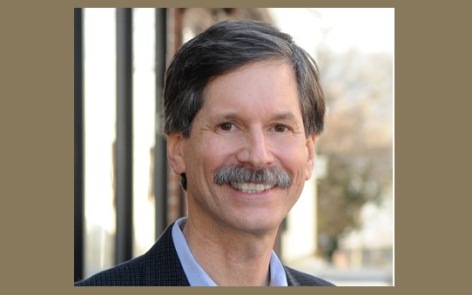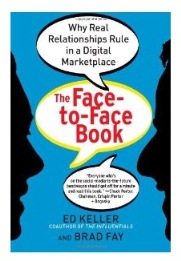Social Marketing: Past is Prologue, Part 2 - Ed Keller

On May 22, Brad Fay's and my new book, THE FACE-TO-FACE BOOK: Why Real Relationships Rule in a Digital Marketplace, will be published. You can download a free excerpt from the bookhereor find it onlinehere.
As part of our research we looked at the history of word of mouth and social influence, and were reminded that the past is indeed prologue. Myfirst blog on this topic, reviewed the seminal work of Columbia Professors Paul Lazarsfeld and Elihu Katz – Personal Influence . Here I discuss the origins of word of mouth advertising and its relevance to today.
reminded that the past is indeed prologue. Myfirst blog on this topic, reviewed the seminal work of Columbia Professors Paul Lazarsfeld and Elihu Katz – Personal Influence . Here I discuss the origins of word of mouth advertising and its relevance to today.
The Advent of Word-of-Mouth Advertising
As far as we have been able to determine, the phrase "Word-of-Mouth Advertising" was coined by Ernest Dichter who, in 1966, published an article in the Harvard Business Review entitled, "How Word-of-Mouth Advertising Works"
Dichter was a psychologist by training. His firm focused on consumer behavior and the motivations that drive them, including the role of persuasion in advertising. He is generally considered to be "the father of motivational research," and the first to coin the term "focus group," a technique that helped him understand "why," why people were motivated to buy or do or think something. His work helped advertisers to shift their focus from straightforward product information and statistics, to image and persuasion.
Dichter brought this perspective to his HBR article, which began with the observation that whenever his firm would ask consumers "what made you buy this brand or particular product?" the answer invariably came back, a friend, expert or relative who told me about it. To Dichter, this prompted the important question, "Why in a time of increasing advertising volume does Word-of-Mouth recommendation loom so high?"
To provide answers, Dichterlaunched a large scale research project to investigate the ways in which word-of-mouth recommendations affect advertising, and the flip side – the ways advertising affects word-of-mouth. Dichter's goal was to help advertisers refine their techniques such that they could embrace word of mouth and use it to their advantage, rather than seeing it as a force that was at odds with their advertising.
In many regards, it was a precursor to the desire many marketers have today to integrate three major communications assets – paid, owned and earned media. Rather than treating them as independent silos, or worse, forces that work in opposition to each other, Dichter sought to understand how these assets should work together.
How Can Advertisers Earn Word-of-Mouth?
Dichter provided concrete ideas to advertisers about ways to "earn" word of mouth and thereby earn a bigger return on their investment in "paid" media. Although Dichter's advice was given almost 50 years ago, many of his ideas are similar to the guiding principles that social media and word of mouth practitioners deploy today. Some of these include:
1. Advertisers should provide "proof of friendship" to the consumer, in order to separate themselves from their role as "sales channel" and become a trusted friend of the consumer. Examples include providing small, but thoughtful "gift packages" to say thanks; helping your customer to feel that they are being initiated into an 'exclusive' group by using your product; or "establish audience kinship" through the messages and style of your advertising to illustrate that you have things in common with the customers and truly understand them.
2. Trace "the company myth" – i.e., convey the back story of the product's founding or the way early consumers used it – in order to personalize the product and create authenticity.
3. Provide "customer testimonials" to simulate word of mouth, which if done properly will allow the viewers or readers to believe that the third party endorser is truly speaking spontaneously and truthfully, and not as a "hired hand."
4. Design the advertising itself to provoke, stimulate or produce word of mouth.
Dichter's underlying messages to the advertising community stands the test of time and is as relevant today as it was a half century ago:
· Advertising cannot sell against personal influence;
· Advertising must change from its traditional role of "a salesman who tries to get rid of merchandise," to a new role of "advertiser as that of a friend who recommends a tried and trusted product";
· Advertisers should do so by understanding the steps that make person-to-person interaction powerful, and modify mass media approaches accordingly; and
· There is a ready-made market of "influencers, experts, or aficionados" that can be reached and, in turn, influenced by advertising in the right media and with the appropriate creative approach.
The Golden Age of Advertising, or a Missed Opportunity?
Dichter , together with Katz and Lazarsfeld (whom I wrote about previously) and leading thinkers at that time were (for example, Everett Rogers) were not the only ones to extol the importance of word of mouth and influencers during these "early years," but they were the leading lights and their insights are enduring. The stage was set, and advertisers were challenged to act and behave differently in order to maximize the impact of their marketing efforts by embracing, rather than ignoring the power of personal influence and word of mouth in the buying process.
Sadly, this didn't happen. Instead marketing was overtaken by the era of the "Mad Men." It was an era during which the great ad man David Ogilvy felt it necessary to say to his colleagues: "The consumer isn't a moron; she's your wife." His quote reminds us that it was a male dominated business, and that the consumer certainly wasn't at the center. Advertising executives were enamored with their own brilliant creativity and their ability to persuade the mass market through the power of their ideas, delivered primarily through TV advertising. It was a top-down, "father knows best" world, despite the reality that decisions then (as now) were being made "horizontally and socially."
Many call this time period "the Golden Age of Advertising"; and if you were in the ad business it undoubtedly was. We would call it a three decades long "missed opportunity" for Madison Avenue's clients. During those years, the power of word of mouth advertising, influencer marketing, and the like not only failed to take hold, it began to recede from the marketer's consciousness. There was relatively little focus throughout the rest of the 60's right up through the late 1990's.
In my next and last post on the history of word of mouth, I'll pick things up in the late 1990s with the publication of the Cluetrain Manifesto and it's exhortation that "markets are conversations."
Ed Keller, CEO of theKeller Fay Group, has been called "one of the most recognized names in word of mouth." The publication of Keller's book,The Influentials, has been called the "seminal moment in the development of word of mouth." His new book,The Face-to-Face Book, is coming out in May 2012. You can follow Ed Keller onTwitter,FacebookandGoogle+, or contact him directly at ekeller@kellerfay.com.
Read all Ed’s MediaBizBloggers commentaries at WOM Matters.
Check us out on Facebook at MediaBizBloggers.com
Follow our Twitter updates @MediaBizBlogger
The opinions and points of view expressed in this commentary are exclusively the views of the author and do not necessarily represent the views of MediaBizBloggers.com management or associated bloggers. MediaBizBloggers is an open thought leadership platform and readers may share their comments and opinions in response to all commentaries.


